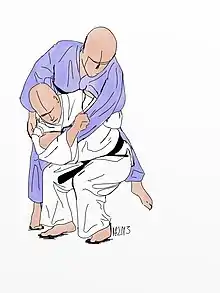Seoi nage
Seoi nage (背負投) is a shoulder throw, one of the traditional forty throws of Judo as developed by Jigoro Kano. It belongs to the first group, Dai Ikkyo, of the traditional throwing list, Gokyo (no waza), of Kodokan Judo. It is also part of the current 67 Throws of Kodokan Judo. It is classified as a hand technique, te-waza, and is the second throw performed in the Nage-no-kata.
| Seoi-nage | |
|---|---|
 Illustration of Seoi Nage Judo throw | |
| Classification | Nage-waza |
| Sub classification | Te-waza |
| Targets | Arm |
| Kodokan | Yes |
| Technique name | |
| Rōmaji | Seoi nage |
| Japanese | 背負投 |
| English | Shoulder throw |
| Korean | 업어치기 |
Variations

The specific techniques of morote-seoi-nage (two hands seoi-nage), or eri-seoi, are usually generalised as simply seoi-nage. The distinctive technical aspect of this classification is that tori (the one executing the technique) grips with their two hands,[1] as opposed to Ippon Seoi Nage, in which only one hand remains gripping while the other slides under uke's (the one receiving the technique) armpit. Additionally, reverse seoi-nage involves spinning up to 360 degrees so that uke ends up being thrown backwards rather than forward, as in other variations.[2] Renowned seoi-nage martial artists are Isao Okano and Toshihiko Koga, and renowned reverse seoi-nage judoka is Choi Min-ho, who popularised the variation.
Origin
Seoi nage is likely to have developed from the jujutsu throw empi nage in which an arm bar is used as leverage to throw uke over tori’s shoulder. [3]
Notes
- Kodokan Institute. "Seoi-Nage (hand technique)". Kodokan.org. Archived from the original on 9 August 2011. Retrieved 26 July 2011.
- "Reverse Seoi-Nage". Retrieved 2020-01-30.
- Craig, Darrell Max: Japan’s ultimate martial art; Jujitsu before 1882, The classical Japanese art of self-defense, Tuttle Publishing, 1995, ISBN 0-8048-3027-4, p.73
References
- Ohlenkamp, Neil (2006) Judo Unleashed basic reference on judo. ISBN 0-07-147534-6.
Further reading
- Nakanishi, Hidetoshi (1992), "Seoi-nage", Judo Masterclass Techniques (second ed.), Ippon Books, ISBN 0-9518455-4-3
